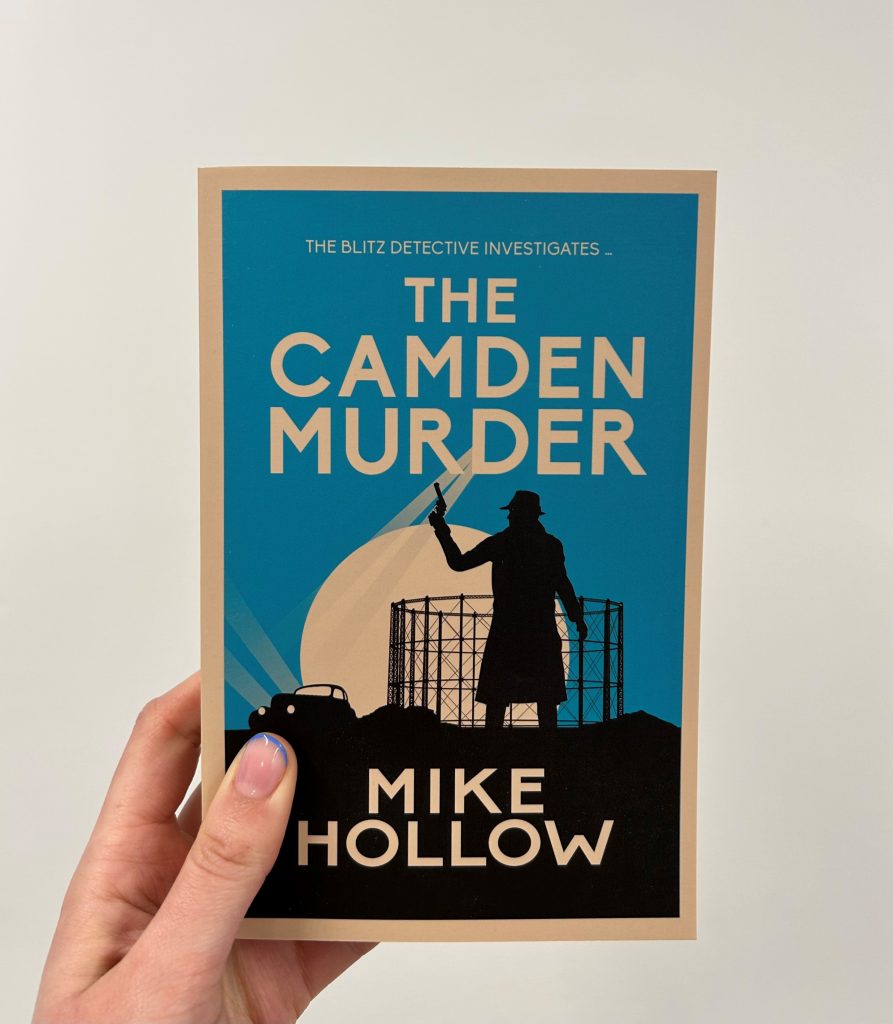Buried Treasure – A guest blog post from Mike Hollow
To celebrate the publication of The Camden Murder in paperback this month, we asked Mike Hollow to share a guest blog post on his writing process.

Back in the days when I was teetering on the brink of parenthood, it used to be said that the average British family had 2.4 children. I never met that family, but it might explain why the house we bought appeared to have been designed with 2.4 bedrooms. No space, then, for a study, or even a writer’s cramped corner. But decades later we still live there, not least because we discovered that by some happenstance it had a buried treasure – a cellar. Four extra unsuspected – and most importantly dry – rooms.
One of these secret spaces became my office, where I’m writing this now, and where I write my Blitz Detective mysteries. It’s perfect: I can get on quietly with my work here any time of the day or night, with shelves of background reference books within arm’s reach, a double desk strewn with notes, and no windows to distract.
There’s another little room down here, just six feet by eight, that in some unconscious ironic homage to Agatha Christie’s favoured murder scene we laughingly call ‘the library’, because it’s lined from floor to ceiling with books. Only once have I ever found a dead body in it, lying spreadeagled on the floor, but forensic examination confirmed its identity as not human but rodent, so I removed the corpse and disposed of it discreetly. Later a man was charged, but he wasn’t the killer.
The only thing we lack in this house is a big room. The kind where you can bring all the suspects together at the end of the story and work your way round them, accusing and excusing them one by one until you finally arrive at the murderer – and then, flash bang wallop the case is solved and we can put the kettle on.
I used to think our accommodation was on the small side, until I started writing The Camden Murder, number seven in the Blitz Detective series. It starts with a body found in a blazing car beside the Regent’s Canal in north London. Today this is at the heart of the tourist magnet that is Camden Lock, but in 1940, when my story is set, it was a grimy working canal, where narrowboats plied their way up and down carrying everything from ice to iron.
I wanted to develop a character who lived and worked on a narrowboat, and as I embarked on my own voyage of canal-life research I was amazed at how they lived back then. Boat people spent their whole life living on a narrowboat, where the cabin measured barely seven feet wide and not much more in length. This was the space where they lived, ate and slept, the whole family and all their belongings in that one tiny room. And don’t forget, people had more children in those days – none of that 2.4 business – so there could be any number of kids to fit in too. How did they cope with that? Well, as my boat man character relates in the book, when the kids got too big they’d be farmed out to relatives or friends and start working on someone else’s boat. Some were as young as eight when they had to leave home in this way.
Wooden narrowboats were not renowned for their protection against bombs, either. London in 1940 was at the height of the Blitz, with nightly air raids bringing waves of death and destruction to the city below. The canals at that time were still important transport links, moving vital supplies around the country, and as good a strategic target as the docks and railways. I wondered what it was like for the boat people when the sirens went off – householders ‘on the bank’, as they called everywhere that wasn’t the canal, had their backyard shelters to take refuge in, but if you lived on a narrowboat you couldn’t exactly tow an Anderson shelter behind you.
The canal workers had to take their chance along with everyone else, hoping the next bomb would land somewhere else. As my story grew, other characters emerged. Businessmen, commercial travellers, even estate agents, all doing their best to keep working as normal despite the air raids – and all linked in some way with a man’s mysterious murder.
Times have changed since then, but as I spent months living (in my head) in Camden Town in 1940 I grew to know these people well. Yes, there was a war on – a vast and historic conflict that spread around the whole world – but still it was a world made up of ordinary little people like me, confronted by extraordinary stresses and challenges, stretched to the limit just coping with their own inconspicuous life.
Small is beautiful, or so they say. In 1940, the giants who bestrode the world were Churchill, Roosevelt, Hitler, Stalin, and the world they presided over was ugly. But for me, the beauty lay in the nameless people who battled their way to work in the morning through the night’s rubble and ruins, who loved and were loved amidst the falling bombs, and who did their duty as best they could. These are the kind of people who bestride, in their small way, the pages of The Camden Murder.
But a word of caution. As you read the book, you may find that one of them – or more? – is a murderer …
Click here to purchase The Camden Murder in paperback. Click here to learn about the Blitz Detective series.
Don’t forget to follow us on Instagram, Facebook, and Twitter to keep up with the latest news!


